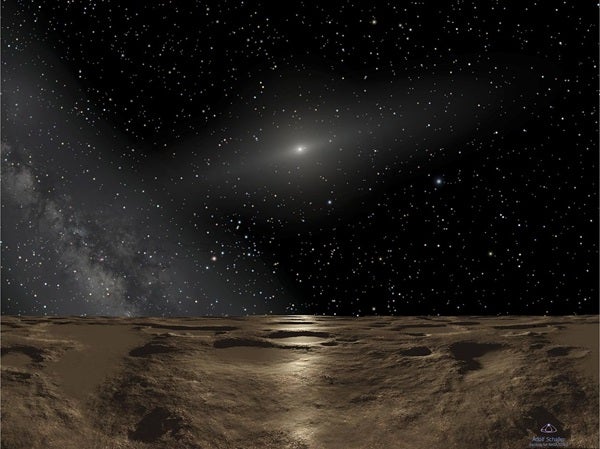Several newly discovered objects on the outskirts of the solar system suggest that something strange is afoot. While some scientists point to the odd behavior of the newfound residents as further proof for the existence of the hypothetical Planet Nine (a yet-unseen superEarth proposed to inhabit the outskirts) not everyone is convinced.
The new inhabitants include a small icy world with one of the longest known orbits and several smaller objects clustered together extremely far from the sun.
The newest of these objects is L91, an icy world that can travel as far from the sun as 1430 astronomical units (AU), or 1,430 times the Earth-sun distance, one of the longest known orbital periods. L91 never draws closer to the sun than 50 AUs, farther away than even Pluto.
And L91’s distant path is shifting.
“It’s orbit is changing in quite a remarkable way,” astrophysicist Michele Bannister told scientists last week at the American Astronomical Society’s Division for Planetary Sciences in Pasadena, California. Bannister, an astrophysicist at Queen’s University Belfast, identified minute changes in the object’s orbit that could come from the passing gravity of other stars or interactions with the hypothetical Planet Nine. Simulations by the team suggest that the tiny tugs are more likely to come from beyond the solar system, whether distant stars or galactic winds.
Konstantin Batygin, an astronomer at the California Institute of Technology, said, “I think it’s a story that’s not implausible, but I also think it’s not needed.” Batygin, who announced the existence of Planet Nine last January, thinks the unusual orbits of L91 and other newfound objects are more likely explained by the hypothetical planet.
Bannister and her team spotted L91 using the Outer Solar System Origins Survey, a 4-year survey hunting distant moving objects using the Canada-France-Hawaii Telescope. L91’s mass and size remains unknown.
“It’s right at the limit of what we could actually detect in the sky,” Bannister said.
‘Something is happening’
L91 isn’t the only new object in the sky. Another team of astronomers reported a handful of smaller icy bodies traveling beyond Neptune. Similarities in the orbits of objects like these led to the proposal of Planet Nine.
“A lot is going on in the outer solar system,” said Scott Sheppard of the Carnegie Institution for Science in Washington, D.C. Sheppard is part of a team of astronomers conducting the largest, deepest survey of trans-Neptunian objects, whose orbits take them farther out than Neptune. The team found several new objects clustered in the outer edges of the solar system.
One of these objects, 2014 FE72, is the first known to come from the Oort Cloud, the icy shell around the solar system where comets are born. With an orbit that takes it out more than 3,000 AUs, it may also suffer from the influence of passing stars or the gravity of Planet Nine
Sheppard and his colleagues have been mapping the sky in detail since 2007. So far, they’ve only covered about 10 percent of what he calls “the most interesting part of the sky.”
But not all scientists are convinced that the increasing number of odd orbits points to Planet Nine.
“We did search some parts of the sky more thoroughly than others,” says astronomer Katherine Volk, a planetary scientist at the University of Arizona. Volk analyzed the growing studies offered up as evidence for the hypothetical planet, and remains skeptical that it is the only conclusion. “You find things where you’re looking,” she says.
She pointed out that the similarities in orbits, or clustering, of the objects could be related to their similar positions in the sky.
“If the clustering persists at the end of [Sheppard’s] survey, it will be more convincing,” she said.
At the same conference, Batygin reported that Planet 9 could be responsible for the backwards, or retrograde, orbit of some of the solar system’s centaurs. Orbiting among the outer planets, centaurs cross the orbits of their larger neighbors. And Elizabeth Bailey, a graduate student at Caltech working with Batygin, reported that Planet 9 could have tilted the orbit of the solar system’s planets with respect to the sun, solving another long-standing astronomical mystery.
Again, Volk isn’t convinced that the research proves the existence of Planet Nine, though she said Batygin and Bailey’s had drawn reasonable conclusions.
“There are all these different, slightly odd things,” she said. “No one piece of evidence is really convincing me that for sure there is a planet there, [but] the fact that there are multiple things probably says something is happening.”










